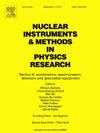GRBAlpha和VZLUSAT-2立方体卫星上SiPMs三年多在轨辐射损伤特性
IF 1.4
3区 物理与天体物理
Q3 INSTRUMENTS & INSTRUMENTATION
Nuclear Instruments & Methods in Physics Research Section A-accelerators Spectrometers Detectors and Associated Equipment
Pub Date : 2025-04-14
DOI:10.1016/j.nima.2025.170513
引用次数: 0
摘要
硅光电倍增管容易受到辐射损伤,导致暗计数率增加。这导致结合SiPM和闪烁体的伽玛射线探测器的低能量阈值增加。尽管存在这些缺点,但由于其工作电压低,尺寸小,对低光强的线性响应和快速响应,它们正成为立方体卫星上基于闪烁体的伽马射线探测器的首选。在新的星载任务中,sipm越来越受欢迎,因此有必要描述它们在空间环境中的长期性能。在这项工作中,我们报告了Hamamatsu的S13360-3050 PE多像素光子计数器(MPPCs)的暗计数率和低能量阈值的变化,使用GRBAlpha和VZLUSAT-2立方体卫星在近地轨道(LEO)上跨越三年的测量数据。对MPPCs在太空中的性能进行如此长时间的测量之前从未发表过。GRBAlpha是一颗1U立方体卫星,于2021年3月22日发射到550公里高度的太阳同步极轨道(SSO)上,携带一个基于8个MPPCs的CsI(Tl)闪烁体读数的伽马射线探测器,定期探测能量范围为~ 30−900 keV的伽马射线瞬态,如伽马射线暴和太阳耀斑。VZLUSAT-2是一颗3U立方体卫星,于2022年1月13日发射,也发射到535公里的高度,除了其他有效载荷外,还携带了两个类似于gralpha上的伽马射线探测器。我们已经对Hamamatsu MPPCs S13360-3050 PE进行了飞行验证,并证明了由2.5 mm PbSb合金屏蔽的MPPCs可以在近地轨道环境中用于持续三年以上的科学任务。这表明MPPCs在未来卫星中应用的潜力。本文章由计算机程序翻译,如有差异,请以英文原文为准。
Characterization of more than three years of in-orbit radiation damage of SiPMs on GRBAlpha and VZLUSAT-2 CubeSats
Silicon photomultipliers (SiPMs) are prone to radiation damage which causes an increase of dark count rate. This leads to an increase in low-energy threshold in a gamma-ray detector combining SiPM and a scintillator. Despite this drawback, they are becoming preferred for scintillator-based gamma-ray detectors on CubeSats due to their low operation voltage, small size, linear response to low light intensity and fast response. This increasing popularity of SiPMs among new spaceborne missions makes it important to characterize their long-term performance in the space environment. In this work, we report the change of the dark count rate and low-energy threshold of S13360-3050 PE multi-pixel photon counters (MPPCs) by Hamamatsu, using measurements acquired by the GRBAlpha and VZLUSAT-2 CubeSats at low Earth orbit (LEO) spanning over three years. Such a long measurement of the performance of MPPCs in space has not been published before. GRBAlpha is a 1U CubeSat launched on March 22, 2021, to a 550 km altitude sun-synchronous polar orbit (SSO) carrying on board a gamma-ray detector based on CsI(Tl) scintillator readout by eight MPPCs and regularly detecting gamma-ray transients such as gamma-ray bursts and solar flares in the energy range of keV. VZLUSAT-2 is a 3U CubeSat launched on January 13, 2022 also to a 535 km altitude SSO carrying on board, among other payloads, two gamma-ray detectors similar to the one on GRBAlpha. We have flight-proven the Hamamatsu MPPCs S13360-3050 PE and demonstrated that MPPCs, shielded by 2.5 mm of PbSb alloy, can be used in LEO environment on a scientific mission lasting beyond three years. This manifests the potential of MPPCs being employed in future satellites.
求助全文
通过发布文献求助,成功后即可免费获取论文全文。
去求助
来源期刊
CiteScore
3.20
自引率
21.40%
发文量
787
审稿时长
1 months
期刊介绍:
Section A of Nuclear Instruments and Methods in Physics Research publishes papers on design, manufacturing and performance of scientific instruments with an emphasis on large scale facilities. This includes the development of particle accelerators, ion sources, beam transport systems and target arrangements as well as the use of secondary phenomena such as synchrotron radiation and free electron lasers. It also includes all types of instrumentation for the detection and spectrometry of radiations from high energy processes and nuclear decays, as well as instrumentation for experiments at nuclear reactors. Specialized electronics for nuclear and other types of spectrometry as well as computerization of measurements and control systems in this area also find their place in the A section.
Theoretical as well as experimental papers are accepted.

 求助内容:
求助内容: 应助结果提醒方式:
应助结果提醒方式:


